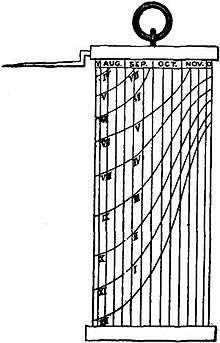Shepherd's dial

A shepherd's dial (also known as a pillar dial or cylinder) is a type of sundial that measures the height of the sun via the so-called umbra versa.[1] Its design needs to incorporate a fixed latitude, but it is small and portable. It is named after Pyrenean shepherds, who would trace such a sundial on their staffs. This type of sundial was very popular in the 16th, 17th and 18th centuries.
History
Since the ancient Roman era, people have created sundials which measure differences in the sun's height above the horizon over the course of the day - Vitruvius describes them as viatoria pensilia.[2] The earliest description of a shepherd's dial as known today was written by Hermann of Reichenau, an 11th-century Benedictine monk who called it a cylindrus horarius. It was also known in the Middle Ages as a chilinder oxoniensis (Oxford cylinder). Such sundials did not need aligning north-south and so became very popular,[3] appearing in Renaissance artworks such as Holbein's 1528 Portrait of Nicolaus Kratzer and his 1533 The Ambassadors.[4]
Concept
References
- ↑ Claudia Kren, (1977), The Traveler's Dial in the Late Middle Ages: The Chilinder, Society for the History of Technology, Vol. 18, No. 3 (Jul., 1977), pp. 419-435
- ↑ Derek De Solla Price, (1969), "Portable sundials in the antiquity", Centaurus, 14, págs. 242-266
- ↑ Allan A. Mills, (1996), Altitude sundials for seasonal and equal hours, Annals of Science, Vol. 53, nº 1, DOI: 10.1080/00033799600200121, pags. 75-85
- ↑ Stebbins, F. A., (1962), The Astronomical Instruments in Holbein's "Ambassadors", Journal of the Royal Astronomical Society of Canada, Vol. 56, pág.45